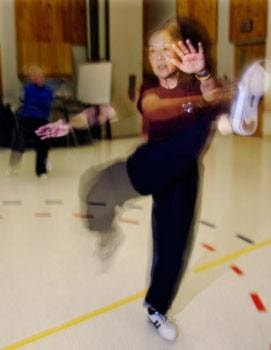EAGLE
When Phil Joy was airlifted off Eagle Summit during the 2006 Yukon Quest, along with four other mushers, he thought it was a unique incident.
But now, the Fairbanks’ musher isn’t so sure.
Back to give it another shot this year, Joy is beginning to question what type of race the Quest really is.
“Is it a dog race, or a survival race?” said Joy, unthawing his beard inside the Eagle checkpoint on Wednesday night.
It’s advertised as a tough dog race, he said.
“But when you enter a dog race, you expect trail markers. So that in a storm you can still find them with reasonable skill.”
The markers on Eagle Summit had blown away the year Joy was rescued.
And this year the trail along the Yukon River, often weaving through severe jumble ice, wasn’t much better.
“The way the Yukon is marked, if one inch of snow falls you’re done,” said Joy.
“You won’t find your way around.”
If that’s the point of the race — surviving — then it should be advertised accordingly, he said.
“It’s ridiculous. Not only are there not enough markers, half of them aren’t reflective — so they’re worthless until you trip over them.”
This year, it was Eagle Summit that had the best trail markings, said Joy.
“So, maybe, if someone gets lost and needs to be rescued on the Yukon River they’ll start marking that better too.”
It’s not just the rookies and back-of-the-packers whining about the trail marking, he added.
People who know the race are saying it’s absurd.
“It’s ridiculous,” said former champ Bill Cotter, sitting down and joining Joy in the old Eagle schoolhouse.
“I’ll be glad to get over to the Canadian side,” he said.
The Canadian side of the Quest trail is put in by Yukon Rangers; they started work on it in the middle of January.
The markers don’t reflect, added Cotter.
“I’m surprised anyone found the trail in the dark.”
Every year there are major complaints about the trail markers, said former Quest musher Wayne Hall, who lives in Eagle and helps run the checkpoint.
“And every year they say they are going to do something about it, and they never do.”
“It seems the more we bitch about the trail the worse the markings gets,” said veteran Kelly Griffin, joining the group.
In ‘87, when Cotter won the race; he went from Carmacks all the way to Dawson without seeing one trail marker.
There were lots of other trails, he said.
“So why didn’t you get lost?” said Joy.
“I knew the route,” said Cotter.
“That’s the only reason.”
Pelly Crossing wasn’t a checkpoint at that time.
This will be Cotter’s first time running over American Summit, the 1,026-metre mountain outside Eagle. The race used to trace the Yukon River all the way to Dawson, he said.
But this year mushers are looking forward to getting off the river.
“I had dogs falling into crevasses between huge blocks of ice and then being dragged back out,” said Joy.
“It was pretty rough,” said Cotter, who was aching all over.
“If there was a dusting of snow in that jumble ice, you’d be blind trying to work your way through there,” said Joy.
Even in the daylight, Joy got lost a couple times and ended up in deep snow surrounded by shards and blocks of ice trying to make his way back to the trail.
“And the dogs were crawling over blocks of ice and the sled was banging around,” he said.
Joy, who’s down to eight dogs, has so many sore ones he was considering resting 18 hours in Eagle.
This year, teams also got lost between Fairbanks and the first checkpoint 160 kilometres away at Chena Hot Springs.
“And that was the start of the race — people were fresh and wide awake,” said Joy.
The only reason Joy didn’t end up out on the highway was because he ran into Cotter, who’d hit the main road and had to turn around and come back.
Colorado musher Bill Pinkham ended up getting dragged down the highway and tore up his sled bag, said Joy.
When the race ends in Fairbanks next year, and everyone is exhausted, it could be a disaster, he said.
This was something Hall, who plans to run the 2009 Quest, was already worried about.
“I don’t want to get lost at the end,” he said.
Joy is not blaming the volunteers who mark the trail.
“It’s the race organizers, with paid jobs, who should be responsible and make sure it gets done,” he said.
If the Quest wants more mushers in the race, it needs to spend money on the trail, said Dawson rookie Ann Ledwidge, resting up in Eagle on Thursday.
“Some sections of the trail are awesome and some are just pathetic,” she said.
“That’s why you’re not getting more mushers signing up for the race, you’ve got to have a good trail.”
It should at least be marked, said Ledwidge.
“You’ve got to see where you’re going.
“It’s a tough race, but then there’s ridiculously tough.”
The Quest has a huge budget, and it doesn’t hesitate to spend money on anything else, so maybe it should spend some of it putting in a good trail, she said.
“They should be paying someone to start putting in the trail a month before the race,” not rely on volunteers who are putting it in the day before.
Ledwidge wouldn’t run the Quest again now that she’s seen the condition of the trail from Fairbanks to Eagle.
“If I was going to do another 1,000-mile race, I’d do the Iditarod,” she said.
